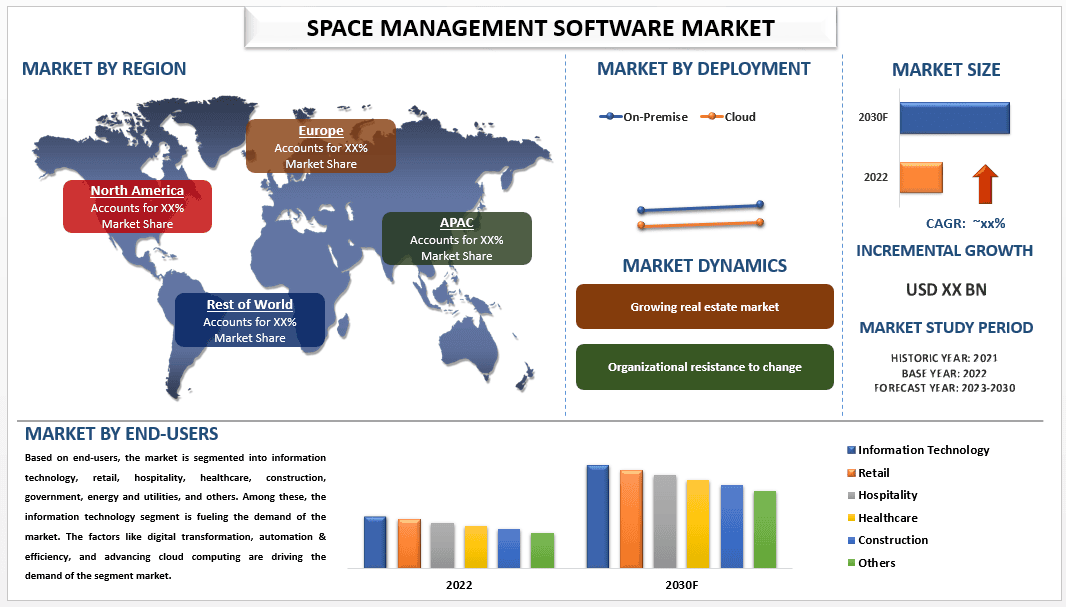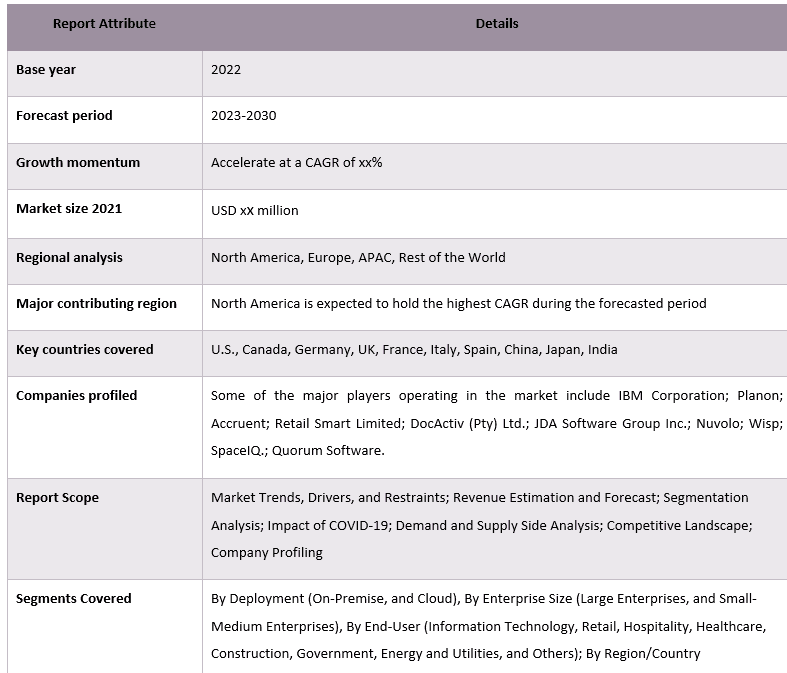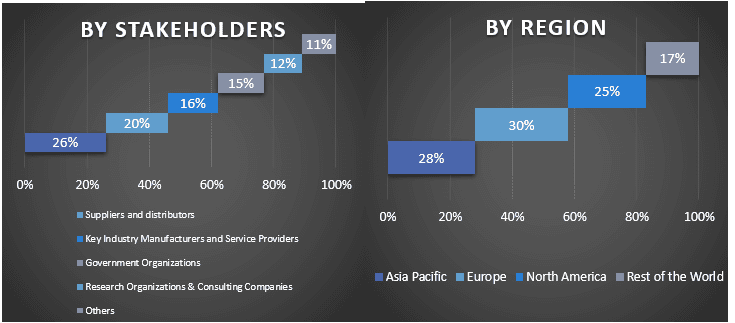- Home
- About Us
- Industry
- Services
- Reading
- Contact Us
Space Management Software Market: Current Analysis and Forecast (2022-2030)
Emphasis on Deployment (On-Premises, And Cloud); Enterprise Size (Large Enterprises, And Small-Medium Enterprises); End-user (Information Technology, Retail, Hospitality, Healthcare, Construction, Government, Energy and Utilities and Others); Region/Country.

The Space Management Software Market is expected to grow at a strong CAGR of xx% during the forecast owing to the increasing demand for efficient space utilization. Space management software refers to a type of computer program or application designed to help organizations efficiently manage their physical spaces. This software typically provides tools and features to assist in various aspects of space utilization, allocation, planning, and optimization. The growing popularity of co-working spaces and shared offices has created a need for efficient space management solutions. Space management software helps co-working operators effectively allocate spaces, manage bookings, and optimize resource utilization in these shared environments.
Some of the major players operating in the market include IBM Corporation; Planon; Accruent; Retail Smart Limited; DocActiv (Pty) Ltd.; JDA Software Group Inc.; Nuvolo; Wisp; SpaceIQ.; Quorum Software.
Insights Presented in the Report
“Amongst deployment, the clouds segment captured the majority share of the Space Management Software market in 2022.”
Based on deployment, the market is bifurcated into on-premise and cloud. Among these, the cloud segment is leading the market. Cloud technology played a significant role in driving the space management software market by offering numerous benefits and enabling advanced functionalities.
“Amongst Enterprise Size, the large enterprise size segment captured the majority share of the Space Management Software market in 2022.”
Based on the enterprise size, the market is bifurcated into large enterprises and small-medium enterprises. Among these large enterprise segment is leading the market as large enterprises often have extensive and complex physical space requirements due to their size, multiple locations, and diverse business operations and therefore driving the space management software market.
Space Management Software Market Report Coverage

“North America holds the largest share of the Space Management Software Market in 2022.”
North American organizations, particularly in major business hubs such as the United States and Canada, have been placing a strong emphasis on workplace optimization. The region is seeking ways to enhance employee productivity, collaboration, and well-being through effective space management. Space management software offers the tools and insights needed to optimize space allocation, utilization, and design and thus growing the demand of the market in that region.
Reasons to buy this report:
- The study includes market sizing and forecasting analysis validated by authenticated key industry experts.
- The report presents a quick review of overall industry performance at one glance.
- The report covers an in-depth analysis of prominent industry peers with a primary focus on key business financials, product portfolios, expansion strategies, and recent developments.
- Detailed examination of drivers, restraints, key trends, and opportunities prevailing in the industry.
- The study comprehensively covers the market across different segments.
- Deep dive regional level analysis of the industry.
Customization Options:
The global space management software market can further be customized as per the requirement or any other market segment. Besides this, UMI understands that you may have your own business needs, hence feel free to contact us to get a report that completely suits your requirements.
Table of Content
Research Methodology for the Space Management Software Market Analysis (2023-2030)
Analyzing the historical market, estimating the current market, and forecasting the future market of the global Space Management Software market were the three major steps undertaken to create and analyze the adoption of Space Management Software in major regions globally. Exhaustive secondary research was conducted to collect the historical market numbers and estimate the current market size. Secondly, to validate these insights, numerous findings and assumptions were taken into consideration. Moreover, exhaustive primary interviews were also conducted, with industry experts across the value chain of the global Space Management Software market. Post assumption and validation of market numbers through primary interviews, we employed a top-down/bottom-up approach to forecasting the complete market size. Thereafter, market breakdown and data triangulation methods were adopted to estimate and analyze the market size of segments and sub-segments of the industry pertains to. Detailed methodology is explained below:
Analysis of Historical Market Size
Step 1: In-Depth Study of Secondary Sources:
Detail secondary study was conducted to obtain the historical market size of the Space Management Software market through company internal sources such as annual reports & financial statements, performance presentations, press releases, etc., and external sources including journals, news & articles, government publications, competitor publications, sector reports, third-party database, and other credible publications.
Step 2: Market Segmentation:
After obtaining the historical market size of the Space Management Software market, we conducted a detailed secondary analysis to gather historical market insights and share for different segments & sub-segments for major regions. Major segments are included in the report as deployment, enterprise-size, and end-users. Further country-level analyses were conducted to evaluate the overall adoption of testing models in that region.
Step 3: Factor Analysis:
After acquiring the historical market size of different segments and sub-segments, we conducted a detailed factor analysis to estimate the current market size of the Space Management Software market. Further, we conducted factor analysis using dependent and independent variables such as type, service, and mode. A thorough analysis was conducted of demand and supply-side scenarios considering top partnerships, mergers and acquisitions, business expansion, and product launches in the Space Management Software market sector across the globe.
Current Market Size Estimate & Forecast
Current Market Sizing: Based on actionable insights from the above 3 steps, we arrived at the current market size, key players in the global Space Management Software market, and market shares of the segments. All the required percentage shares split and market breakdowns were determined using the above-mentioned secondary approach and were verified through primary interviews.
Estimation & Forecasting: For market estimation and forecast, weights were assigned to different factors including drivers & trends, restraints, and opportunities available for the stakeholders. After analyzing these factors, relevant forecasting techniques i.e., the top-down/bottom-up approach were applied to arrive at the market forecast for 2030 for different segments and sub-segments across the major markets globally. The research methodology adopted to estimate the market size encompasses:
- The industry’s market size, in terms of revenue (USD) and the adoption rate of the Space Management Software market across the major markets domestically
- All percentage shares, splits, and breakdowns of market segments and sub-segments.
- Key players in the global Space Management Software market in terms of products offered. Also, the growth strategies adopted by these players to compete in the fast-growing market
Market Size and Share Validation
Primary Research: In-depth interviews were conducted with the Key Opinion Leaders (KOLs) including Top Level Executives (CXO/VPs, Sales Head, Marketing Head, Operational Head, Regional Head, Country Head, etc.) across major regions. Primary research findings were then summarized, and statistical analysis was performed to prove the stated hypothesis. Inputs from primary research were consolidated with secondary findings, hence turning information into actionable insights.
Split of Primary Participants in Different Regions

Market Engineering
The data triangulation technique was employed to complete the overall market estimation and to arrive at precise statistical numbers for each segment and sub-segment of the global Space Management Software market. Data was split into several segments & sub-segments post studying various parameters and trends in the areas of the component, application, industry, and deployment mode in the global Space Management Software market.
The main objective of the Global Space Management Software Market Study
The current & future market trends of the global Space Management Software market were pinpointed in the study. Investors can gain strategic insights to base their discretion for investments on the qualitative and quantitative analysis performed in the study. Current and future market trends determined the overall attractiveness of the market at a regional level, providing a platform for the industrial participant to exploit the untapped market to benefit from a first-mover advantage. Other quantitative goals of the studies include:
- Analyze the current and forecast market size of the Space Management Software market in terms of value (USD). Also, analyze the current and forecast market size of different segments and sub-segments.
- Segments in the study include areas of deployment, enterprise size and end-user.
- Define and analysis of the regulatory framework for the Space Management Software industry.
- Analyze the value chain involved with the presence of various intermediaries, along with analyzing customer and competitor behaviors of the industry.
- Analyze the current and forecast market size of the Space Management Software market for the major region.
- Major countries of regions studied in the report include Asia Pacific, Europe, North America, and the Rest of the World
- Company profiles of the Space Management Software market and the growth strategies adopted by the market players to sustain in the fast-growing market.
- Deep dive regional level analysis of the industry
Related Reports
Customers who bought this item also bought










